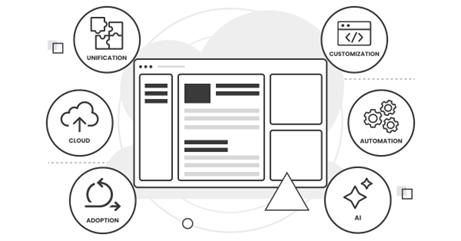Up until recently, most contact centers either used the customer relationship management (CRM) application for agent desktops or they relied on the embedded desktop that came with their contact center software. However, modern customer service operations demand richer, customizable workspaces.
Large contact centers, in particular, need to consolidate multiple applications and workflows into unified, tailored, agent experiences. Many large enterprises have turned to web frameworks like React to build custom desktop applications from the ground up.
CRM and contact center as a service (CCaaS) providers have also evolved their offerings. Salesforce created Lightning specifically to meet demanding contact center customization requirements. Other leading CRM providers — Microsoft, Oracle, SAP, and ServiceNow — followed suit by embedding robust customization capabilities and softphone integration into their platforms. Additionally, contact center vendors have modernized by adding support for digital channels and features for agent engagement and enablement. Recently, top cloud contact center players — AWS, Five9, Genesys, and NICE — have overhauled their agent desktop solutions.
As the scope of customer-facing employee desktops expanded, the industry adopted the term "workspace" to describe these more comprehensive solutions. However, in its latest survey, Gartner found only one-third of service leaders think their workspace investment is paying dividends.
The good news is that other operations to build your agent workspaces have blossomed. Today, enterprises with complex needs face a critical decision for their agent desktop that needs to factor in several key considerations. Let’s explore each one.
Workplace Users Need a Single Pane of Glass
With agents needing access to 7 applications on average during a customer service interaction, consolidating them into a unified experience is crucial. Constant context switching between disparate applications and browser tabs severely reduces productivity while imposing a substantial cognitive burden on agents. This hinders their ability to deliver great customer experiences.
Seamless integration is paramount - and it starts with unifying access to the contact center and CRM platforms. But other systems should be consolidated as well into a single pane of glass. Some digital channels are often managed using specialized software. Large companies also utilize various back-end systems to generate 360-degree customer views and handle service workflows. While modern REST APIs are being widely adopted, legacy system integrations still rely on other methods like SOAP, WebSockets, proprietary Java, and Win32 APIs.
Workplaces Need Customization
One telling statistic underscores the importance of customization flexibility: according to Gartner, over 60% of customer service representatives report being overwhelmed by irrelevant information.
As enterprises build unified infrastructures that touch numerous departments, they must accommodate multiple business units serving various segments, using different applications, and having role-specific needs for sales, onboarding, support, and collections. They need the flexibility to choose the workspace container app - be it the CRM, a collaboration platform like Teams, or dedicated software.
Standard tabbed interfaces and tiled layouts can have agents still clicking and scrolling through their desktops. Instead, next-generation workspaces should let you federate data from multiple applications into a single, context-driven widget and provide options to control the user focus area.
Workplaces Need Automation
Automating agent workflows poses unique challenges due to high exception volumes and human decision points. There are three broad automation technologies a workspace solution will use; below are the pros and cons for each. Success requires an agile approach - start small with a segment of a process and a few scenarios before expanding the scope through rapid iteration.
Robotic Process Automation (RPA) can be easily overlaid on customer service stacks to handle repetitive, rules-based tasks. However, RPA can be difficult to maintain as contact center environments frequently change. Scripts are prone to breaking and challenging to fix.
Workflow automation better handles sophisticated logic and human decisions. Popularity has grown with low-code options now native to modern CRM and CCaaS platforms, albeit still requiring heavy integration work with legacy systems. Testing interdependent workflows is difficult though and exception handling also remains challenging.
Event-driven orchestration recently emerged as a compelling option. Pioneered in finance before being standardized by the Financial Desktop Connectivity and Collaboration Consortium (FDC3), event-driven frameworks make automation more adaptable to changes. They enable no-code implementation, faster testing, and easier maintenance.
Workplaces Need AI assistance and guidance
According to NTT CX benchmarking report, 70% of customer interactions required some form of human assistance, thus making AI an integral component of a modern agent workspace, because it can automate tedious tasks and assist agents with complex customer interactions.
AI has blossomed into an array of technologies – from agent assist that retrieves knowledge base articles to guidance systems offering contextual cues, next-best-action recommendations, and summarization tools aiding after-call work.
Each addresses different pain points. An optimal workspace provides access to leading AI assistants and copilots, dynamically pulling the most relevant one based on the specific interaction context.
Workplaces Need to Encourage Agent Adoption
With Gertner reporting that 45% of agents avoid using newly-provided tools, poor technology adoption has become a pressing issue. Successful adoption requires managing workspaces like a product - driving incremental updates, soliciting user feedback, and incorporating it rapidly via agile iterations.
Change can seem daunting for contact centers with complex ecosystems, requiring extensive testing. Thus, your workspace technology must enable continuous desktop modifications and include a toolset for rapid testing and validation cycles. This agile approach is preferable to prolonged, expensive testing that impedes iteration.
When Migrating to the Cloud, Work in Stages
The prevailing contact center migration path has been to pilot a new cloud platform with a subset of agents before flipping the entire center post-validation.
However, this doesn't work for larger operations. They need to consolidate centers using different systems into a unified cloud infrastructure, while possibly preserving some legacy apps. Also, their scale necessitates gradual legacy retirement and incremental transitions.
Thus, most enterprises devise phased migration strategies, hinging on decoupling the agent workspace from back-end systems. A solution that connects to legacy and future applications provides flexibility and insulates agents from underlying infrastructure shifts.
Keep an Eye on These Options for Agent Desktops
Along with these evolving requirements, new options have emerged across 5 categories:
- CCaaS built-in workspaces have evolved beyond solely accessing their feature sets, becoming extensible through APIs to incorporate third-party applications within tabbed interfaces.
- Desktop specialists, such as NovelVox, Upland InGenius, and Upstream Works have created workspaces that can handle multiple contact center applications and federate access to CRM and third-party applications.
- All major CRM applications have developed highly customizable workspaces including softphone and messaging widgets connectable to various interaction management systems. They provide app builders and leverage their back-ends to enable workflow automation and data federation across applications. Low-code platforms like Appian and Pega offer similar solutions independent of any CRM system.
- Event-driven frameworks combine customizable workspaces with event-driven orchestration for data exchange and automation. They provide domain-specific specialization - such as io and OpenFin for finance or AMC Technology and Coral for contact centers, including prebuilt integrations with the most widely-used applications in their target industries.
- Web development frameworks such as Angular, React, and Vue offer maximum flexibility for building customized workspaces. Yet they also necessitate creating custom integrations and developing frameworks for data exchange and automation.
As workspaces take on a more strategic role to enable customer-facing employees, enterprises must carefully consider all their options. In a second part, we will cover recommended exploration steps and key evaluation criteria.










